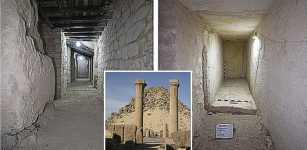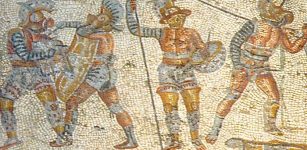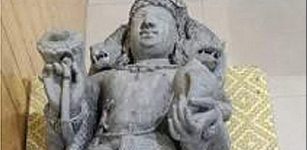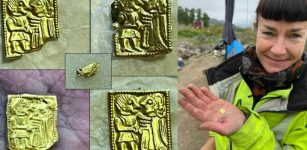Legend Of Marguerite de Bressieux: Brave Noblewoman Who Sought Revenge For Sexual Assault
A. Sutherland - AncientPages.com - They say it is only a legend, nothing more. You can believe it or not. Still, it could be a true story that could happen in any location at any time.
Ruins of Anjou Castle. The castle has a long history. With this castle is associated the memory of the Edict of Roussillon (August 8, 1564) by which Charles IX and Catherine de Medici imposed the date of January 1 as the first day of the year for the entire kingdom of France. Sold shortly after the Revolution, the castle of Anjou was largely destroyed between 1806 and 1813. Credit: Raydou - CC BY-SA 4.0
According to Humbert de Terrebasse (1842-1927), a lawyer and historian, this event took place during the Hundred Years' War (1337 - 1453), a struggle between England and France over a series of disputes, including the question of the legitimate succession to the French crown.
Ruins of Anjou Castle. The castle has a long history. With this castle is associated the memory of the Edict of Roussillon (August 8, 1564), by which Charles IX and Catherine de Medici imposed the date of January 1 as the first day of the year for the entire kingdom of France. Sold shortly after the Revolution, the castle of Anjou was largely destroyed between 1806 and 1813. Credit: Raydou - CC BY-SA 4.0
Marguerite de Bressieux was a French noblewoman born in Anjou, France, and lived in a castle with her parents.
The legend says that the castle was besieged and pillaged by rebel troops attempting to topple King Charles VII on behalf of a Burgundian nobleman, Louis de Chalon, the Prince of Orange.
Marguerite's father and mother were killed. The soldiers of Chalon raped her, her ladies-in-waiting, and other noblewomen. Marguerite buried the parents and then swore bloody revenge on Chalon and his ruthless men, whose shameless act proved to be the last they had committed.
However, they were not yet aware of what awaited them. Soon after the tragic incident, Marguerite and her ladies-in-waiting armed themselves and started military training that included riding in battle and sword fighting. Deeply motivated and ready to fight, they had only waited for the chance to encounter Chalon and his men in a competition.
Luckily, the women did not have to wait long. Finally, the king was ready to retaliate against Louis. When Marguerite heard that royal troops led by Raoul de Gaucort, governor of the Dauphiné, were being assembled to march against Chalon's soldiers, she made necessary preparations for the departure of her small group of female warriors in disguise.
Clad in black with faces covered with black scarves and with a pike or lance in one hand, they mounted their horses. One held a black banner decorated with heads superimposed over bones and silver tears. In the middle of these funeral emblems, there was an orange pierced by a spear, under which an inscription was visible: "Ainsi tu seras" ("Thus shall you be").
The orange was associated with Louis Chalon, the Prince of Orange.
Led by Marguerite de Bressieux, these brave women were perfectly aware of war risks and would not be denied their revenge.
At first, Gaucourt hesitated to allow Marguerite and her companions into his army but listened carefully to what the women had to say.
"Deign, noble lord, to accord us a place in your ranks. If our arms are weak, our hearts are strong and bent upon nothing but vengeance. Victims of the most cowardly, the most degrading outrage, we aspire to wash it out in blood." 1
Gaucort respected the determination of Marguerite and her companions and let them join the troops of King Charles VII on their way to encounter Chalon, Prince of Orange, and his men. Now a confrontation was imminent, and when it took place, Chalon's soldiers were surprised and could not believe their eyes.
They took the female warriors for frightening ghosts, who emerged from hell to take revenge on the living, but the women were real.
The black horse riders in disguise raised their visors before Chalon and his team. They bravely looked into the eyes of each of their rapists, who fled, terrified of fighting ghosts. They were chased by the royal troops who massacred them mercilessly, pushing the last of them into the Rhône River.
The legend further tells that Marguerite was deadly wounded in battle and had to wait for help for too long. Finally, her companions took her to a nearby convent, but she died several hours later.
She was buried with military funeral honors, and her companions decided to stay in the convent for the rest of their lives.
According to the legend, it happened in 1450 in France during the Hundred Years' War (1337-1453).
Updated on December 27, 2023
Written by – A. Sutherland - AncientPages.com Senior Staff Writer
Copyright © AncientPages.com All rights reserved. This material may not be published, broadcast, rewritten or redistributed in whole or part without the express written permission of AncientPages.com
Expand for referencesReferences:
- Schmermund E. Women Warriors
More From Ancient Pages
-
 Mystery Of The Lost Biblical City Of Ai – Where Was It Located?
Ancient Mysteries | Apr 23, 2017
Mystery Of The Lost Biblical City Of Ai – Where Was It Located?
Ancient Mysteries | Apr 23, 2017 -
 Forbidden Ancient Manuscripts Almost Erased From History – Unusual Myths, Beliefs And Practices – Part 2
Ancient Mysteries | May 11, 2018
Forbidden Ancient Manuscripts Almost Erased From History – Unusual Myths, Beliefs And Practices – Part 2
Ancient Mysteries | May 11, 2018 -
 Could Vancouver Island’s Hepburn Stone Be 15,000 Years Old?
Artifacts | Feb 20, 2021
Could Vancouver Island’s Hepburn Stone Be 15,000 Years Old?
Artifacts | Feb 20, 2021 -
 Excavation And Restoration Of New Rooms In The Pyramid Of Sahura In Abusir
Archaeology | Sep 27, 2023
Excavation And Restoration Of New Rooms In The Pyramid Of Sahura In Abusir
Archaeology | Sep 27, 2023 -
 Were There Gladiators In Roman Britain? An Expert Reviews The Evidence
Featured Stories | Mar 14, 2023
Were There Gladiators In Roman Britain? An Expert Reviews The Evidence
Featured Stories | Mar 14, 2023 -
 Ancient History Of New Year’s Celebrations And Traditions From Around The World
Ancient Traditions And Customs | Dec 31, 2024
Ancient History Of New Year’s Celebrations And Traditions From Around The World
Ancient Traditions And Customs | Dec 31, 2024 -
 Mystery Of The Medieval ‘Out Of Time’ Village In England
Featured Stories | Mar 21, 2024
Mystery Of The Medieval ‘Out Of Time’ Village In England
Featured Stories | Mar 21, 2024 -
 Sculpture Of Lord Vishnu Dated To The Early 9th Century Found In Kashmir
Archaeology | Aug 4, 2022
Sculpture Of Lord Vishnu Dated To The Early 9th Century Found In Kashmir
Archaeology | Aug 4, 2022 -
 Will-o’-the-wisp: Eerie Lights Over Swamps And Marshes That Frightened And Led People Astray
Featured Stories | Apr 23, 2020
Will-o’-the-wisp: Eerie Lights Over Swamps And Marshes That Frightened And Led People Astray
Featured Stories | Apr 23, 2020 -
 Eating And Social Habits Of People In The Balearic Islands 3,000 Years Ago – Reconstructed
Archaeology | Jan 18, 2023
Eating And Social Habits Of People In The Balearic Islands 3,000 Years Ago – Reconstructed
Archaeology | Jan 18, 2023 -
 Mysterious Ichthys – Ancient Secret Christian Symbol With A Deep Meaning
Ancient Symbols | Mar 6, 2018
Mysterious Ichthys – Ancient Secret Christian Symbol With A Deep Meaning
Ancient Symbols | Mar 6, 2018 -
 Mystery Of The Giant Boulder In North Salem
Featured Stories | Aug 8, 2019
Mystery Of The Giant Boulder In North Salem
Featured Stories | Aug 8, 2019 -
 Mysterious Ancient Inscriptions Never Meant To Be Read – Biblical Secrets Revealed
Ancient Mysteries | May 17, 2018
Mysterious Ancient Inscriptions Never Meant To Be Read – Biblical Secrets Revealed
Ancient Mysteries | May 17, 2018 -
 Mysterious Tiny 1,400-Year-Old Gold Foil Figures Found In Pagan Temple
Archaeology | Sep 23, 2023
Mysterious Tiny 1,400-Year-Old Gold Foil Figures Found In Pagan Temple
Archaeology | Sep 23, 2023 -
 Kalpa Tree ‘Kalpavriksha’: The Sacred Wishing Tree Has Been Object Of Adornment And Worship Since Ancient Times
Featured Stories | Jul 22, 2016
Kalpa Tree ‘Kalpavriksha’: The Sacred Wishing Tree Has Been Object Of Adornment And Worship Since Ancient Times
Featured Stories | Jul 22, 2016 -
 ‘Sea Monsters’ Were Real Millions Of Years Ago: New Fossils Tell About Their Rise And Fall
Featured Stories | Oct 8, 2022
‘Sea Monsters’ Were Real Millions Of Years Ago: New Fossils Tell About Their Rise And Fall
Featured Stories | Oct 8, 2022 -
 Axum: Mysterious Megalithic Towering Obelisks In Ethiopia
Civilizations | Aug 21, 2018
Axum: Mysterious Megalithic Towering Obelisks In Ethiopia
Civilizations | Aug 21, 2018 -
 Colors On These Ancient Pots Hint At The Power Of An Empire
Archaeology | Mar 7, 2023
Colors On These Ancient Pots Hint At The Power Of An Empire
Archaeology | Mar 7, 2023 -
 Evidence Of Copper Processing Unearthed At Archaeological Site In Oman
Archaeology | Mar 6, 2024
Evidence Of Copper Processing Unearthed At Archaeological Site In Oman
Archaeology | Mar 6, 2024 -
 Master Kong Confucius: Great Philosopher And ‘Teacher Of All Teachers’ Ahead Of His Time
Featured Stories | Nov 25, 2016
Master Kong Confucius: Great Philosopher And ‘Teacher Of All Teachers’ Ahead Of His Time
Featured Stories | Nov 25, 2016


